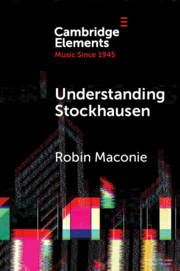Refine search
Actions for selected content:
12 results
Chapter 19 - In Praise of Pierre
- from Part III - Engagements with the Post-War Generation of Composers
-
-
- Book:
- Boulez in Context
- Published online:
- 08 July 2025
- Print publication:
- 24 July 2025, pp 200-212
-
- Chapter
- Export citation
Chapter 15 - Boulez and Stockhausen
- from Part III - Engagements with the Post-War Generation of Composers
-
-
- Book:
- Boulez in Context
- Published online:
- 08 July 2025
- Print publication:
- 24 July 2025, pp 152-163
-
- Chapter
- Export citation
Chapter 17 - The Articulatory Function of Space
- from Part III - Engagements with the Post-War Generation of Composers
-
-
- Book:
- Boulez in Context
- Published online:
- 08 July 2025
- Print publication:
- 24 July 2025, pp 174-185
-
- Chapter
- Export citation
Chapter 16 - Festival Time at Donaueschingen, Darmstadt and Le Domaine Musical
- from Part III - Engagements with the Post-War Generation of Composers
-
-
- Book:
- Boulez in Context
- Published online:
- 08 July 2025
- Print publication:
- 24 July 2025, pp 164-173
-
- Chapter
- Export citation
Chapter 13 - Pierre Boulez and His Contemporaries
- from Part III - Engagements with the Post-War Generation of Composers
-
-
- Book:
- Boulez in Context
- Published online:
- 08 July 2025
- Print publication:
- 24 July 2025, pp 125-136
-
- Chapter
- Export citation
Chapter 29 - An Explosive Confrontation
- from Part IV - Concepts and Legacy
-
-
- Book:
- Messiaen in Context
- Published online:
- 09 November 2023
- Print publication:
- 30 November 2023, pp 267-277
-
- Chapter
- Export citation
1 - Theorising Serialism
- from Part I - Contexts I
-
-
- Book:
- The Cambridge Companion to Serialism
- Published online:
- 07 March 2023
- Print publication:
- 16 February 2023, pp 3-19
-
- Chapter
- Export citation

Understanding Stockhausen
-
- Published online:
- 28 November 2022
- Print publication:
- 22 December 2022
-
- Element
- Export citation
Chapter 19 - Singers
- from Part III - Performance and Publishing
-
-
- Book:
- Brahms in Context
- Published online:
- 15 May 2019
- Print publication:
- 09 May 2019, pp 187-195
-
- Chapter
- Export citation
Part II - Identities, Environments and Influences
-
- Book:
- Brahms in Context
- Published online:
- 15 May 2019
- Print publication:
- 09 May 2019, pp 69-184
-
- Chapter
- Export citation
Part III - Performance and Publishing
-
- Book:
- Brahms in Context
- Published online:
- 15 May 2019
- Print publication:
- 09 May 2019, pp 185-256
-
- Chapter
- Export citation
Chapter 9 - As Pianist
- from Part II - Identities, Environments and Influences
-
-
- Book:
- Brahms in Context
- Published online:
- 15 May 2019
- Print publication:
- 09 May 2019, pp 80-87
-
- Chapter
- Export citation
